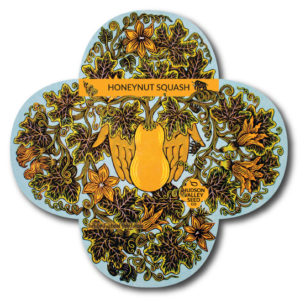 For those of us who love our winter squash, the end of October is a treasure trove. But are you familiar with one of our most prized gems, Honeynut Squash? It has that classic butternut shape only more compact, its skins darken to a lovely honey-gold tone, and its deep orange flesh tastes as rich as it looks. While cooking a classic butternut can be a mammoth task, the diminutive Honeynut is just right for a meal or two. You might say this petite cucurbit is ideal for human consumption. But the species Cucurbita moschata, to which it belongs, certainly didn't start out that way. It turns out Honeynut is a little squash with a long history.
For those of us who love our winter squash, the end of October is a treasure trove. But are you familiar with one of our most prized gems, Honeynut Squash? It has that classic butternut shape only more compact, its skins darken to a lovely honey-gold tone, and its deep orange flesh tastes as rich as it looks. While cooking a classic butternut can be a mammoth task, the diminutive Honeynut is just right for a meal or two. You might say this petite cucurbit is ideal for human consumption. But the species Cucurbita moschata, to which it belongs, certainly didn't start out that way. It turns out Honeynut is a little squash with a long history.
It begins further back than you might imagine, during the time of the mastodons. That's right, mastodons--those giant, elephantine creatures you see in museums of natural history nowadays--who went extinct about 10,500 years ago. They browsed on ancient undergrowth, and the cucurbit varieties that grew at that time made up part of their diet. Does munching on raw winter squash seem a little unappetizing? Just wait till you learn that ancient cucurbits held little resemblance to our beloved Honeynut. These fruits were large, bitter, and seedy--inedible to humans past or present. But mastodons had different tastes, giant molars, and bigger guts. Their stature also had a huge impact on the soil, creating disturbances that were ideal squash habitat.
It was humans who brought about the downfall of the mastodons, hunting them to extinction as they spread into the Americas. As cultures settled and flourished there, the once-inedible squashes were cultivated and crafted into a very important crop. The earliest scientific evidence of a squash-people connection was found in caves in Ecuador, with seeds dating back 12,000 years. In fact, the word squash has its origins in a Coastal Algonquin language. Throughout the Americas, squash was essential to the symbiotic relationship with beans and maize, which was referred to by the Iroquois as the "Three Sisters."
In recent years, plant breeding and selection have become a science, taken up by laboratories such as the one at Cornell University. Their breeding efforts focus on creating nutritious varieties that will thrive in the Northeastern US. Honeynut Squash's fantastic production for organic growers is why we love it--that and all the other sweet things we've already mentioned about it! We love it so much, in fact, that we graced its Art Pack with one of Tugboat Printshop's intensely detailed woodcut prints, complete with miniaturized mastodons.
If you grew Honeynut Squash this year, we want you to know three things: One, congratulations! You're following a long, long line of eaters, breeders, growers, and seed savers. Two, read up on how to store it for winter. You won't want a single squash to go to waste. And three, you're in for a treat! Wondering about that underlying complexity of flavor beneath Honeynut's burst of candy sweetness? It's millions of years of history, shrunk down into a single bite of a small squash.






